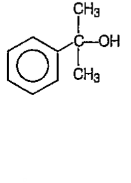Choose an allylic alcohol form the given options.
CH2=CH−CH2−OH
CH2=CH−OH


The correct Answer is:A
To determine which of the given options is an allylic alcohol, we need to understand the definitions and characteristics of allylic alcohols.
1. Understanding Alcohols:
- Alcohols are organic compounds that contain one or more hydroxyl (–OH) groups attached to a carbon atom. The carbon atom to which the –OH group is attached is called the alcohol carbon.
Hint: Remember that the presence of the –OH group is what defines an alcohol.
2. Defining Allylic Alcohol:
- An allylic alcohol is a specific type of alcohol where the hydroxyl group (–OH) is attached to a carbon atom that is adjacent to a carbon-carbon double bond (C=C). This means that the carbon with the –OH group is sp³ hybridized and is next to a carbon that is part of a vinyl group (C=C).
Hint: Allylic alcohols have the –OH group on a carbon that is next to a double bond.
3. Identifying Vinyl Group:
- A vinyl group is defined as a carbon-carbon double bond (C=C) where one of the carbons is also attached to a hydrogen atom. The structure of a vinyl group can be represented as –CH=CH2.
Hint: Look for the presence of a double bond in the structure to identify vinyl groups.
4. Analyzing the Options:
- We need to evaluate each option provided to see which one fits the definition of allylic alcohol:
- Option A: If the structure is CH2=CH-CH2OH, the –OH group is on the carbon adjacent to the double bond, making this an allylic alcohol.
- Option B: If the structure is CH2=CH2OH, the –OH group is on a carbon that is part of the double bond itself, making this a vinylic alcohol, not allylic.
- Option C: If the structure has a carbon attached to a benzene ring with an –OH group, this is not an allylic alcohol as it does not have the required adjacent double bond.
- Option D: If the structure is a benzyl alcohol (where the –OH is attached to a carbon that is part of a benzene ring), this is also not an allylic alcohol.
Hint: Compare the structure of each option to the definition of allylic alcohol to make your determination.
5. Conclusion:
- After analyzing all the options, we find that Option A is the only structure that qualifies as an allylic alcohol because the –OH group is attached to a carbon that is adjacent to a carbon-carbon double bond.
Final Answer: Option A is the correct allylic alcohol.
- Alcohols are organic compounds that contain one or more hydroxyl (–OH) groups attached to a carbon atom. The carbon atom to which the –OH group is attached is called the alcohol carbon.
- An allylic alcohol is a specific type of alcohol where the hydroxyl group (–OH) is attached to a carbon atom that is adjacent to a carbon-carbon double bond (C=C). This means that the carbon with the –OH group is sp³ hybridized and is next to a carbon that is part of a vinyl group (C=C).
- A vinyl group is defined as a carbon-carbon double bond (C=C) where one of the carbons is also attached to a hydrogen atom. The structure of a vinyl group can be represented as –CH=CH2.
- We need to evaluate each option provided to see which one fits the definition of allylic alcohol:
- Option A: If the structure is CH2=CH-CH2OH, the –OH group is on the carbon adjacent to the double bond, making this an allylic alcohol.
- Option B: If the structure is CH2=CH2OH, the –OH group is on a carbon that is part of the double bond itself, making this a vinylic alcohol, not allylic.
- Option C: If the structure has a carbon attached to a benzene ring with an –OH group, this is not an allylic alcohol as it does not have the required adjacent double bond.
- Option D: If the structure is a benzyl alcohol (where the –OH is attached to a carbon that is part of a benzene ring), this is also not an allylic alcohol.
- After analyzing all the options, we find that Option A is the only structure that qualifies as an allylic alcohol because the –OH group is attached to a carbon that is adjacent to a carbon-carbon double bond.
Similar Questions
Knowledge Check
Choose an allylic alcohol form the given options.
ACH2=CH−CH2−OHBCH2=CH−OHC D
D
Choose the arylamine (s) from the given options.
ABenzylamineBBenzylamineCTribenzylamineDAll of the aboveIdentify the primary alcohol among the given options.
A B
B C
C D
D

Identify allylic alcohols in the above examples.
View SolutionIdentify allylic alcohols in the above examples.
View SolutionChoose the odd number out of the given options.
View SolutionChoose the odd number out of the given options.
View SolutionChoose the odd number out of the given options.
View Solution
